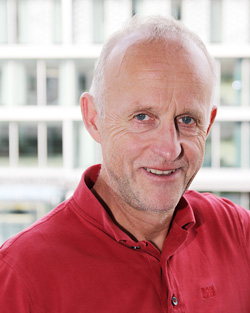
- Date of birth: 070853
- Present position: Professor of Palliative Medicine, Faculty of Medicine, NTNU.
- Vice managing director, St. Olavs Hospital, Trondheim University Hospital.
- Director of the European Palliative Care Research Centre, Faculty of Medicine, NTNU.
| Education: | |
|---|---|
| 1980 | Medical doctor, University of Oslo |
| 1989 | Certified specialist in Oncology |
| 1989 | PhD (dr.med.), University of Oslo |
| Work experience: | |
| 1980-81 | Internship in surgery and internal medicine, Notodden Hospital, Norway, |
| 1981 | Internship community practice, Fjaler, Norway |
| 1981-82 | Family Medicine in private practice Bærum, Norway |
| 1983-86 | Junior doctor in medical oncology and radiotherapy, The Norwegian Radium Hospital, Oslo |
| 1986-87 | Research fellow/PhD-student, The Norwegian Cancer Society, Oslo, Norway |
| 1988-89 | Junior doctor internal medicine, Diakonhjemmets Hospital/Lovisenberg Hospital, Oslo, Norway |
| 1990-93 | Consultant medical oncology and radiotherapy, The Norwegian Radium Hospital, Oslo, Norway |
| 1990-94 | Chair of the Board, Institute for Environmental Medicine, Faculty of Medicine, NTNU, Trondheim, Norway |
| 2002-06 | Chair of the Board, Institute for Cancer Research and Molecular Medicine, Faculty of Medicine, NTNU, Trondheim, Norway |
| 1993-10 | Director of Palliative Medicine Unit, Trondheim University Hospital, Norway |
| 1993- | Professor of Palliative medicine, Faculty of medicine, NTNU, Norway |
| 2006- 2013 | National Cancer Director, Norwegian Directorate of Health, Oslo, Norway |
| 2009- | Director, European Palliative Care Research Centre, NTNU, Norway |
| 2010- 2013 | Head of the Cancer Clinic, St. Olavs Hospital HF, Trondheim, Norway |
| 2013- | Deputy managing director, St. Olavs Hospital HF, Trondheim, Norway |
| Selected merits/assignments: | |
| 1998-01 | Chair of the Program for Research on Alternative Medicine, The Norwegian Research Council |
| 1999-05 | Member of the Board, Norwegian Association for Palliative Medicine |
| 1999-05 | President of the European Association for Palliative Care, EAPC |
| 2000-05 | Member of the Program Committee for Applied Clinical Research and Alternative Medicine, Norwegian Research Council |
| 1993-07 | Member of the Evaluation Committee for Clinical and Epidemiological Research, The Norwegian Cancer Society |
| 2007-08 | Member of the Program Committee, Patient and Survivor Care, ASCO |
| 2007-08 | Committee Member, Canadian Institutes of Health Research (CIHR) |
| 2007-08 | Reviewer for the “Palliative & End of Life Care” peer review committee, CIHR IRSC, Canada |
| 2007-08 | Section Editor, The Oncologist |
| 2007-09 | Member of the IAEA Group for Palliative Radiotherapy |
| 2007-10 | Chairman, Møbius Research Award, The Norwegian Research Council |
| 2008-09 | Member of the Expert group for the Minister of Health |
| 1993-this date | Professor of Palliative Medicine, Faculty of Medicine, NTNU |
| 1993-this date | Member, European Association for Palliative Care Research Network (EAPC RN) |
| 2005-this date | Editorial board, European Journal of Palliative Care |
| 2006-this date | Co-editor, Palliative Medicine |
| 2007-this date | Co-editor, Oxford Textbook of Palliative Care |
| 2007-this date | Chair, EAPC RN |
| 2007-this date | Member of the Editorial Board of Archives of Medical Science |
| 2007-this date | Member of the Assessment panel for the Australian Government Cancer Clinical Trials. |
| 2008-this date | Reviewer, Wolters Kluwer Health |
| 2008-this date | Board member of International Association of Hospice and Palliative Care, IAHPC |
| 2008-this date | Member, DKNVS Academy (The Royal Norwegian Society of Sciences and Letters) |
| 2009-this date | Chair for European Palliative Care Research Centre (PRC) |
| 2009-this date | Evaluator of proposals for the EU Framework 7 HEALTH-2010 single stage cancer call |
| 2009-this date | Member of the International Advisory Board, Lancet Oncology |
| 2011-this date | Member of the Editorial Board, BMJ Supportive & Palliative Care Journal (SP Care) |
| 2012-this date | Member of the Editorial Board, "The Open Access Journal of Science and Technology" |
| 2012-this date | Editorial Board of Annals of Palliative Medicine (APM |
がん悪液質
要約
悪液質は、進行癌患者の80%以上に認められる。悪液質は食欲不振、筋肉や脂肪組織の損失、免疫力の低下、治療の毒性の増加、身体機能が低下することなどを特徴とする。骨格筋量の損失は悪液質の重要な特徴でもあり、全身化学療法の重要な副作用でもある(1)。
がん悪液質は、その要因の相互関係が単一の治療法では成功することが難しい、複合的な症候群である(2)。
炎症は癌性悪液質の病態生理学において基本であると考えられており、それは単純な飢餓と悪液質の本質的な違いを反映している。
抗炎症特性のある薬剤は、炎症性サイトカインおよび急性期蛋白質応答の両方を低下させるため、悪液質のある癌患者において体重と骨格筋量を改善することができる。この効果は、おそらく、身体能力や自己申告形式のQOLの改善などの重要な患者本位の側面をともなっている(3)。炎症や悪液質における筋肉量の維持に対する運動の影響のエビデンスは限られているが、運動は進行癌患者において身体機能や筋力の面で有用である(4)。
従来の栄養療法は悪液質患者においてエネルギーバランスを改善することがあるが、骨格筋量の維持への影響は限られている。悪液質は栄養だけではで治療することができないが、十分なエネルギーとタンパク質の摂取量を確保することは低栄養を避けるために必須である。
新規の有望な薬物、栄養療法の手法や運動/リハビリテーションプログラムの数が増加している。消耗を防止または改善することを目指す標的療法は、薬理的薬剤、栄養、筋肉タンパク質合成を高め崩壊を減らすための運動などの組み合わせが必要なことがある。いくつかの薬理学的介入により筋肉量を改善する可能性が証明されているが、様々な介入もまたさらに広い範囲で身体機能が改善できるように思われる(6)。次世代の様々な治療は、このような壊滅的な事態を打ち消すことができるかもしれない(5)。
- 1. Fearon K, Strasser F, Anker SD, Bosaeus I, Bruera E, Fainsinger RL, et al. Definition and classification of cancer cachexia: an international consensus. Lancet Oncol. 2011;12(5):489-95.
- 2. Solheim TS, Laird BJ. Evidence base for multimodal therapy in cachexia. Curr Opin Support Palliat Care. 2012;6(4):424-31.
- 3. Solheim TS, Fearon KC, Blum D, Kaasa S. Non-steroidal anti-inflammatory treatment in cancer cachexia: a systematic literature review. Acta Oncol. 2013;52(1):6-17.
- 4. Oldervoll LM, Loge JH, Lydersen S, Paltiel H, Asp MB, Nygaard UV, et al. Physical exercise for cancer patients with advanced disease: a randomized controlled trial. The oncologist. 2011;16(11):1649-57.
- 5. Solheim T, Laird, BJ, Balstad, TR, Stene, G, Bye, A, Fayers, P, Fearon, C, Kaasa, S. A feasibility study of Multimodal Exercise/Nutrition/Anti-inflammatory treatment for Cachexia – the pre-MENAC study. In prep.
- 6. Balstad T, Kaasa, S, Solheim, TS. Multimodal nutrition / anabolic therapy for wasting conditions Curr Opin Clin Nutr Metab Care. 2014;Accepted for publication
(邦訳:日下部俊朗)










